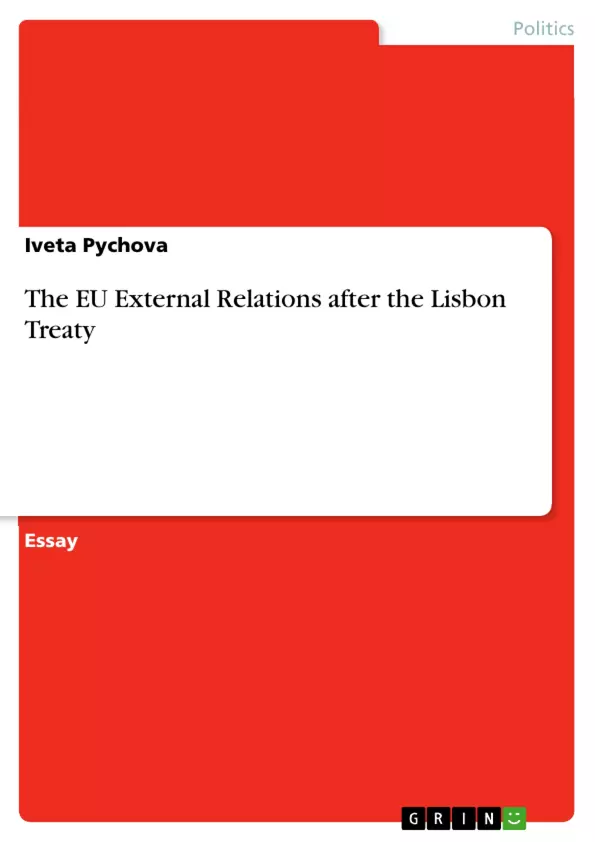The year 2009 was a year of substantive change for the European Union. After almost ten years of long negotiations and many modifications and opt-outs reform treaty, the Lisbon Treaty, was finally ratified by all the 27 Member States of the Union. For some only slightly changed rejected Constitution for Europe, for others a hope of stronger and united Union. As a matter of course the EU needed a reform, indeed. Especially after the eastern enlargement of the European Union in May 2004 it became clear that the Union can not continue to function under the existing treaties that were drafter for 15 Member States.
One of the major changes that the Lisbon Treaty brought is concerning the external representation of the EU, namely the establishment of the President of the European Council, the High Representative of the Union for Foreign Affairs and Security Policy that shall be assisted by a European External Action Service. This will be the main content of this research paper, to determine and analyze the developments within the framework of the external relations of the EU in post-Lisbon period.
The Lisbon Treaty is a result of numerous compromises and appeasements and for many still remains merely relabeled Constitution for Europe that transforms the EU into some kind of “super state” with its own President, Minister of Foreign Affairs and diplomatic crops. These arguments are naturally not entirely wrong. The Lisbon Treaty is practically only modification of previously rejected Treaty establishing a Constitution for Europe and number of criticized items were not removed from the Treaty but simply just renamed with its intended functions unchanged, at least in the area of external relations. One might ask why then all the lengthy and complex proceedings? It looks more like a quarrelling over terminology and some players wanting to gain more time for bargaining.
What remains of a concern is also the positioning of the newly established posts. Many Member States were truly astonished with the selected persons. The citizens of the EU were no less surprised not knowing the man who is going to be their new “President” and hearing most of the time for the first time the name of their “Minister of Foreign Affairs”. Logically, it could be that it was just a strategic step of some of the large Member States who were worried to have a strong and confident people on such high ranked posts.
Inhaltsverzeichnis (Table of Contents)
- Introduction
- Changes brought by the Lisbon Treaty
- The reformed EU = a move from supranationality to intergovernmentalsim?
- High Representative - "A Foreign Minister"
- The EEAS - "A Foreign Service"
- Greater role for the EU Delegations
- The new EU external representation
- Conclusion
Zielsetzung und Themenschwerpunkte (Objectives and Key Themes)
This research paper examines the implications of the Lisbon Treaty on the external relations of the European Union. It specifically analyzes the establishment of the European Council President, the High Representative for Foreign Affairs and Security Policy, and the European External Action Service (EEAS). The paper explores the impact of these changes on the EU's external representation and the balance between supranationality and intergovernmentalism in EU decision-making.
- The impact of the Lisbon Treaty on the EU's external relations
- The establishment of the European Council President and the High Representative for Foreign Affairs and Security Policy
- The creation and role of the European External Action Service (EEAS)
- The shift in the balance between supranationality and intergovernmentalism in EU decision-making
- The evolution of the EU's external representation
Zusammenfassung der Kapitel (Chapter Summaries)
- Introduction: This chapter introduces the Lisbon Treaty as a significant reform for the European Union, particularly in terms of external relations. It highlights the need for reform following the eastern enlargement in 2004 and outlines the focus of the research paper, which is to analyze the changes in EU external relations after the treaty's implementation.
- Changes introduced by the Lisbon Treaty: This chapter discusses the key innovations brought about by the Lisbon Treaty, specifically focusing on the establishment of the European Council President and the High Representative for Foreign Affairs and Security Policy, as well as the creation of the European External Action Service (EEAS). The chapter also explores the intended purpose of the EEAS and the debate surrounding its potential to be a "re-labeled" Ministry of Foreign Affairs.
- The reformed EU = a move from supranationality to intergovernmentalism?: This chapter examines the impact of the Lisbon Treaty on the balance between supranational and intergovernmental elements in EU decision-making. It analyzes the increased power granted to the European Parliament and the potential weakening of the European Commission, suggesting a shift towards greater intergovernmentalism. The chapter also discusses the implications of this shift for the overall functioning and character of the EU.
Schlüsselwörter (Keywords)
The research paper focuses on the impact of the Lisbon Treaty on the European Union's external relations. Key topics include the establishment of the High Representative for Foreign Affairs and Security Policy, the creation of the European External Action Service (EEAS), the balance between supranationality and intergovernmentalism, and the evolution of the EU's external representation.
- Quote paper
- Iveta Pychova (Author), 2010, The EU External Relations after the Lisbon Treaty, Munich, GRIN Verlag, https://www.grin.com/document/164914



